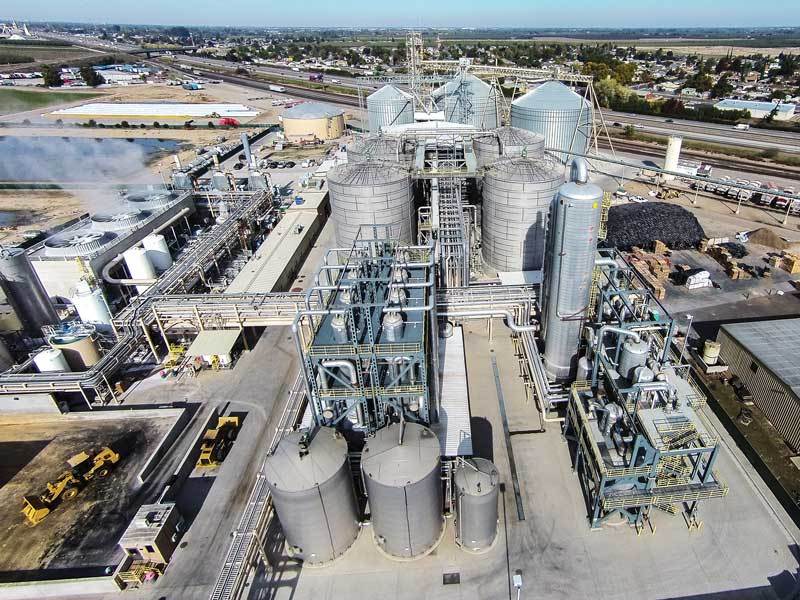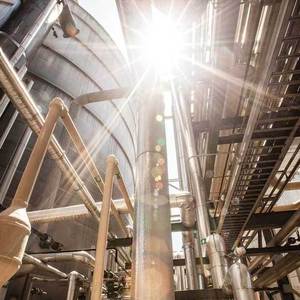Aemetis' Multiple Ventures




September 16, 2016
BY Susanne Retka Schill
Launching new technology ventures is nothing new at Aemetis Inc.—several are in various stages of development. CEO and Chairman Eric McAfee is most enthusiastic about the two projects announced this summer—the acquisition of Edeniq Inc., expected to close soon, and the licensing of LanzaTech technology to build a gasifier alongside its Keyes, California, corn ethanol plant.
In McAfee’s view, Edeniq’s technology is a low-capital, low-risk, fast way to get into cellulosic production. “Edeniq is a pretreatment device and enhancement of fermentation so your existing corn ethanol yields go up, extracting more starch. Your corn oil revenues go up, extracting more corn oil, and for the first time, you are extracting your C5 and more C6 sugars through cellulases, and you are producing cellulosic ethanol.” Adding Edeniq’s Cellunators, a proprietary grind technology, takes about six months from signing the contract, he says, and requires minimal changes to a plant. “We are using standard yeast. We’re not going in and changing the fermentation process, we’re just putting a cellulase enzyme in front of it.”
Pacific Ethanol-Stockton (California) was the first to run Edeniq’s Pathway Technology at commercial scale, announcing the successful trial completion last December. In January, the company applied with the U.S. EPA to register for D3 renewable identification number (RIN) generation, but the registration process that takes a matter of weeks for a first-generation process, was still pending in early September, much to McAfee’s frustration. An EPA spokesman said the review of Pacific Ethanol’s registration has been lengthy for a variety of reasons, the biggest being that it involves a new technology and testing method. “EPA has been working closely with both Pacific Ethanol and Edeniq on these issues, and we expect to resolve them in the very near future. We understand that this technology and testing method could be adopted by many corn ethanol facilities making this initial review at Pacific Ethanol especially important for potential future registrations.”
The challenge is that most cellulosic processes use separate reactors that facilitate measurement. Edeniq’s process comingles first- and second-generation ethanol. McAfee says Edeniq has focused on having robust laboratory tests that reliably document cellulosic gallons produced.
Several are waiting for the critical step of getting the first D3 RIN registration. A modular design, sized at one per 20 MMgy capacity, 29 of Edeniq’s Cellunators are already installed at six ethanol plants. Earlier this year, Edeniq announced four companies had licensed its Pathway technology for cellulosic production: Aemetis, Pacific Ethanol-Stockton, Siouxland Energy Cooperative and Flint Hills Resources. Flint Hills, an Edeniq investor, has installed cellunators at three of its seven plants. In addition, Mid American Agri Products-Wheatland and E Energy Adams have installed cellunators.
Ongoing Projects
The Edeniq acquisition is just one of multiple ventures for Aemetis. Launched in 2006 as AE Biofuels, the company built an integrated cellulose and starch ethanol demonstration facility in 2008 in Butte, Montana, to optimize its ambient temperature starch and cellulose hydrolysis process. Three years later, the company acquired Zymetis Inc., developers of the Z-microbe. Now on the back burner, the technology has been refined at the company’s research facility in Maryland. “The plan there is chemical,” McAfee says. “We have been producing isoprene, which is a valuable $8-per-gallon chemical, produced from corn starch and cellulose.” The technology is ready to go, he adds, once a market opens up for the renewable chemical.
In 2010, the company leased the idled 60 MMgy corn ethanol plant in Keyes, California, originally started up in 2008 by Cilion. Aemetis purchased the plant in 2012 after completing multiple upgrades. Having a commercial corn ethanol plant is a key advantage for a technology developer, McAfee says. “When you don’t own the plant, you have to wait until somebody else adopts the innovation, and that puts you in a huge bind.” That’s been a limiting factor for Edeniq, he adds.
Other ongoing projects include building and operating a liquid carbon dioxide plant at the Keyes facility. The company also is working with alternative feedstocks, receiving a state grant to help with a grain sorghum development program a couple of years ago and, more recently, working with biomass sorghum development.
Aemetis also has a subsidiary on the east coast of India that runs a 50 MMgy biodiesel plant and glycerin refinery. Aemetis has its eye on getting into the renewable diesel/jet fuel market as well, signing a global technology license with ChevronLummus/ARA for the production of 100 percent drop-in renewable jet fuel and diesel.
LanzaTech Project
The project McAfee is most interested in right now is with LanzaTech. The plans announced this summer are to build an 8 MMgy ethanol production facility using LanzaTech’s gasification technology and its proprietary microbe that converts carbon monoxide into ethanol or other chemicals. The project is in the engineering and permitting phase with construction expected to begin in the first quarter of next year, McAfee says. Completion is expected within 10 months.
The LanzaTech project at Aemetis sidesteps a major hurdle faced by most advanced biofuels projects. “We designed the business model to address the core problem,” McAfee says. “Can you finance the construction?” Often, the focus is on the cool feedstock or exciting technology, but the best way to get project financing is to contract an attractive deal for inputs, with a solid market for the output.
Approximately a quarter of the feedstock for the LanzaTech gasifier will be hazardous waste under a long-term contract with a fixed volume and price—in this case, a tipping fee that will be paid to Aemetis. With a shrinking number of landfills able to take hazardous waste, McAfee explains some companies are paying a tipping fee of $600 per ton to get rid of things like oil rags and other materials with oil or trace chemicals. “A key technology player in the deal was actually hauling hazardous waste from central California, 50 miles from our plant, all the way to Texas to get rid of it,” he says. He adds that the volume of the feedstock is not massive and any ethanol produced from the hazardous waste would not be considered cellulosic.
The bulk of the feedstock will be low-cost biomass and, in some cases, agricultural waste that Aemetis will be paid to take. One abundant feedstock will come from almond growers in California’s Central Valley who must dispose of almond wood from about 50,000 acres every year, McAfee explains. For years, biomass power plants have used that feedstock, but many now are shutting down due to a combination of factors, including 15-year air permits not being renewed and tough competition from wind and solar generation in California’s low-carbon market.
The LanzaTech unit will be a separate facility built alongside the corn ethanol plant, with only the final distillation of the ethanol produced being done at the existing plant. In the project’s next phase, the hydrogen coproduct will be used to make renewable jet fuel.
On the other side of the equation, McAfee points out the value of cellulosic ethanol in California is $4.50 per gallon, including the base value of the fuel plus RINs, state and federal credits.
Edeniq, Lanzatech, renewable diesel, isoprene, liquid carbon dioxide make for a lot of moving parts in Aemetis’ short- and long-term plans. “We’re a public company and investors hate uncertainty,” McAfee admits. “In general, investors will read your article and say, ‘There’s so much risk here, there’s all sorts of stuff going on.’ We think about that a lot. How do we reduce complexity for those who don’t know what we’re doing?”
The Edeniq move is the company’s answer. “All we’re doing is taking a corn ethanol plant, and adopting a fully commercial, zero-risk technology,” he says. “There’s zero commercial risk in the Cellunator devise and no commercial risk in the cellulase—it’s fully developed, fully deployed, fully tested. Zero risk.” Figuring a 2.5 percent cellulosic yield at the 60 MMgy plant, it is expected to result in $10 million increased revenue annually. Alluding to the hundreds of millions of dollars invested in cellulosic ethanol development that has been slow to produce a return, McAfee is enthusiastic about Aemetis’ new venture, calling it, “the upgrade where we can actually get something done in our lifetime.”
(Editor's note: After this article was completed for the October print edition, Pacific Ethanol received official notification that it is now registered to generate D3 RINs.)
Author: Susanne Retka Schill
Managing Editor, Ethanol Producer Magazine
sretkaschill@bbiinternational.com
701-738-4922
Advertisement
Advertisement
Related Stories
SAF Magazine and the Commercial Aviation Alternative Fuels Initiative announced the preliminary agenda for the North American SAF Conference and Expo, being held Sept. 22-24 at the Minneapolis Convention Center in Minneapolis, Minnesota.
Saipem has been awarded an EPC contract by Enilive for the expansion of the company’s biorefinery in Porto Marghera, near Venice. The project will boost total nameplate capacity and enable the production of SAF.
Global digital shipbuilder Incat Crowther announced on June 11 the company has been commissioned by Los Angeles operator Catalina Express to design a new low-emission, renewable diesel-powered passenger ferry.
International Air Transport Association has announced the release of the Sustainable Aviation Fuel (SAF) Matchmaker platform, to facilitate SAF procurement between airlines and SAF producers by matching requests for SAF supply with offers.
Alfanar on June 20 officially opened its new office in London, further reaffirming its continued investment in the U.K. The company is developing Lighthouse Green Fuels, a U.K.-based SAF project that is expected to be complete in 2029.
Upcoming Events










